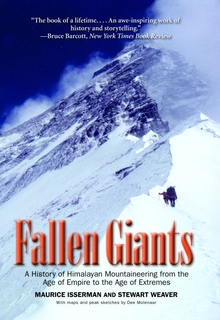Fallen Giants
WARNING
You are viewing an older version of the Yalebooks website. Please visit out new website with more updated information and a better user experience: https://www.yalebooks.com
A History of Himalayan Mountaineering from the Age of Empire to the Age of Extremes
Maurice Isserman and Stewart Weaver; With Maps and Peak Sketches by Dee Molenaar
The story of the world’s highest peaks and the remarkable people who have sought to climb them
The first successful ascent of Mount Everest in 1953 by Sir Edmund Hillary and his Sherpa teammate Tenzing Norgay is a familiar saga, but less well known are the tales of many other adventurers who also came to test their skills and courage against the world’s highest and most dangerous mountains. In this lively and generously illustrated book, historians Maurice Isserman and Stewart Weaver present the first comprehensive history of Himalayan mountaineering in fifty years. They offer detailed, original accounts of the most significant climbs since the 1890s, and they compellingly evoke the social and cultural worlds that gave rise to those expeditions.
The book recounts the adventures of such figures as Martin Conway, who led the first authentic Himalayan climbing expedition in 1892; Fanny Bullock Workman, the pioneer explorer of the Karakoram range; George Mallory, the romantic martyr of Mount Everest fame; Charlie Houston, who led American expeditions to K2 in the 1930s and 1950s; Ang Tharkay, the legendary Sherpa, and many others. Throughout, the authors discuss the effects of political and social change on the world of mountaineering, and they offer a penetrating analysis of a culture that once emphasized teamwork and fellowship among climbers, but now has been eclipsed by a scramble for individual fame and glory.
“In Fallen Giants: A History of Himalayan Mountaineering from the Age of Empire to the Age of Extremes, Maurice Isserman and Stewart Weaver share unforgettable stories of the history of the world’s highest peaks and the climbers who challenged their lofty summits. Their in-depth research gives us unique insights into previously unknown controversies, mysteries, and dramas. This thoughtful book, from a scholarly perspective, introduces us to the greatest peaks and personalities of mountaineering. The new information, intriguing details, insightful interpretations and dry humor make this a must read for armchair mountaineers as well as all who aspire to the heights.”—Arlene Blum, author of Breaking Trail: A Climbing Life
"This book fills a void in the history of mountaineering, and it will appeal not only to climbers but also historians. The authors have done a prodigious amount of research."—John T. Reilly, Mount Saint Mary College
“This will be the definitive history of mountaineering in the Himalaya, clear, free of jargon, and readable, and so thorough that it will not be worth anyone's time to repeat this effort."—Nick Clinch, leader, 1958 American Hidden Peak expedition, and past president, American Alpine Club
“Isserman and Weaver, both unassuming wanderers of high hills, have pulled off a great first ascent: a scholarly, grippingly readable history of Himalayan mountaineering that not only captures the tenuous essence of great successes and failures, but places the accounts of these climbs into historical context.”—Tom Hornbein, author of Everest: The West Ridge
“This would be a great first book to expose a reader to the amazing stories and sacrifices held within the body of mountaineering literature. Additionally, the historian, scholar, and collector will delight in the unique, in-depth look at the evolution of climbing, and its driving factors, in the
“The first comprehensive account of Himalayan mountaineering in fifty years … Many mountaineers date their decision to take up the sport from an encounter with a good book on the subject. If this is the case, then Fallen Giants will surely swell their numbers.” - Good Book Guide
‘Isserman and Weaver brilliantly present the complete picture – the political context, the changing social dynamics, the emergence of modern climbing technique – without losing sight of the need to entertain…Armchair mountaineers will give the book pride of place in their collections.’ — London Review of Books
‘Armchair mountaineers will give the book pride of place in their collections…keep it on a low shelf, where boys and girls can discover it and start dreaming of their own expeditions.’ — London Review of Books
Publication Date: February 23, 2010
65 photos; 15 maps








